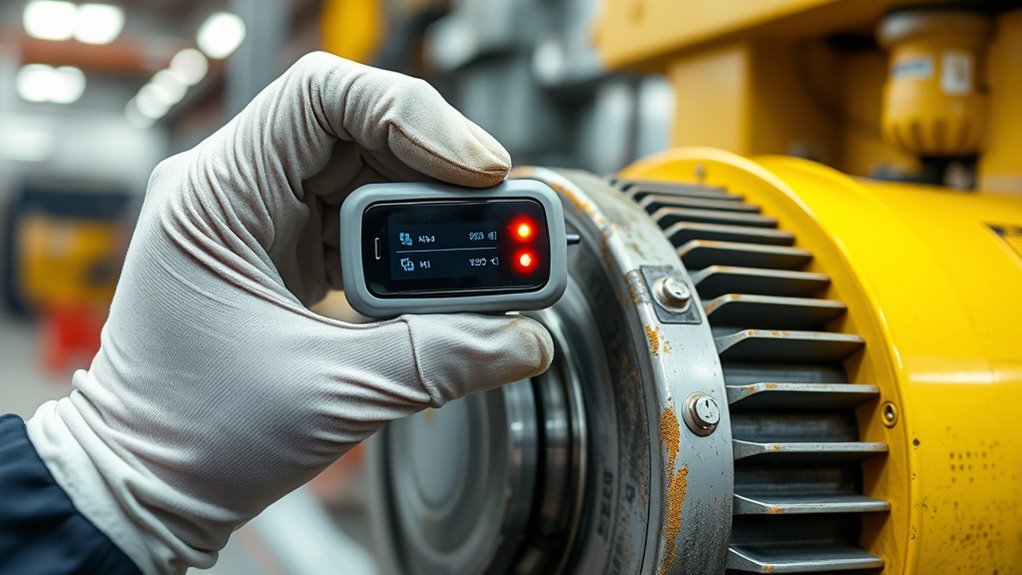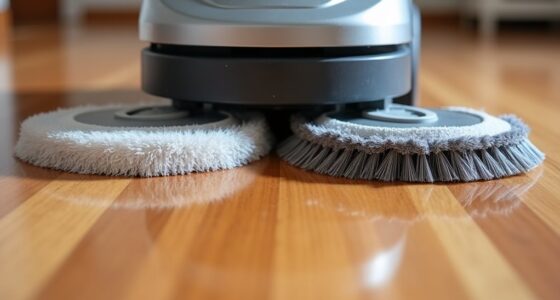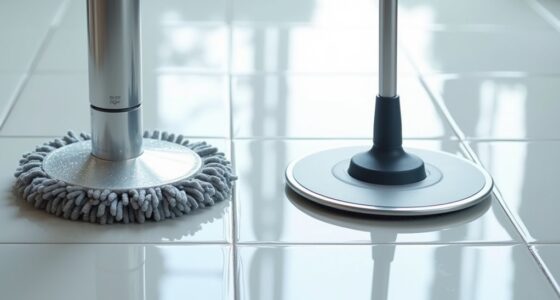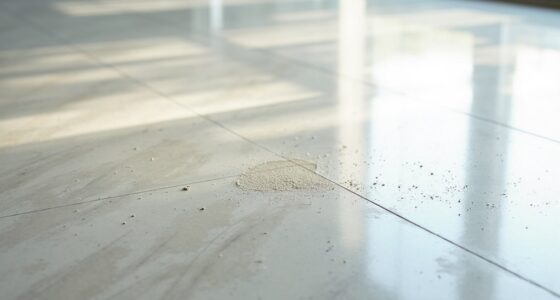To implement effective predictive maintenance for scrubber motors, focus on collecting accurate vibration data with properly calibrated sensors. This helps you detect early signs of wear, misalignment, or imbalance before failures occur. Visualizing this data through clear graphs and dashboards enables quick trend analysis and timely decisions. Maintaining precise sensor calibration guarantees reliable insights, reducing false alarms. Keep exploring further techniques, and you’ll discover more ways to optimize equipment health and prevent costly downtime.
Key Takeaways
- Accurate vibration data collection from scrubber motors is essential for early fault detection and proactive maintenance planning.
- Proper sensor calibration ensures reliable readings, reducing false alarms and missed issues in vibration monitoring.
- Analyzing vibration patterns helps identify signs of wear, misalignment, or imbalance in scrubber motors.
- Visualizing vibration data through dashboards enables quick interpretation of trends and anomalies for timely actions.
- Integrating calibrated sensors and data visualization improves decision-making, reducing unplanned downtime and maintenance costs.

Have you ever wondered how industries prevent costly equipment failures before they happen? It all comes down to predictive maintenance, a proactive approach that leverages real-time data to identify issues before they escalate. When it comes to monitoring scrubber motors, reading vibration data plays a vital role in this process. By analyzing vibration patterns, you can detect early signs of wear, misalignment, or imbalance, allowing maintenance teams to intervene promptly. But to do this effectively, you need accurate sensor calibration. Proper calibration ensures that the vibration sensors provide precise readings, eliminating errors that could lead to false alarms or missed faults. Without correct sensor calibration, your data might be skewed, making it harder to trust the insights you derive from the measurements.
Once the sensors are calibrated, the next step involves data visualization. This process transforms raw vibration data into clear, actionable insights. Instead of sifting through endless numbers, you see trends, anomalies, and patterns at a glance. Graphs, charts, and dashboards help you quickly interpret the health of your scrubber motors. Data visualization tools enable you to identify subtle changes in vibration that might be early indicators of a problem, which otherwise could go unnoticed. By visualizing the data effectively, you can prioritize maintenance actions based on the severity of the issues detected, avoiding unnecessary downtime and reducing maintenance costs.
Integrating sensor calibration and data visualization into your predictive maintenance strategy creates a powerful system. When vibration data is accurate and easy to interpret, you gain confidence in your decision-making. You can set thresholds and alarms for specific vibration levels, so you’re alerted the moment something deviates from normal operation. This early warning capability allows you to schedule repairs during planned outages rather than reacting to catastrophic failures. Over time, analyzing visualized vibration data can reveal patterns linked to specific operational conditions or equipment age, helping you refine maintenance schedules further. Additionally, understanding the importance of sensor calibration ensures that your entire predictive maintenance approach is based on reliable and precise data.
In essence, focusing on sensor calibration and effective data visualization transforms raw vibration signals into a reliable, easy-to-understand picture of your scrubber motor health. This approach enables you to act proactively, extending equipment lifespan and maintaining peak performance. With this strategic use of technology, you’re not just fixing problems after they happen—you’re preventing them altogether. Predictive maintenance, powered by accurate sensors and insightful visualization, becomes your best tool to keep operations running smoothly and avoid costly unplanned outages.
Frequently Asked Questions
What Types of Sensors Are Best for Vibration Analysis in Scrubber Motors?
You should use piezoelectric or MEMS accelerometers for vibration analysis in scrubber motors, as they provide accurate data and are easy to calibrate. Proper sensor calibration guarantees reliable measurements, helping you detect issues early. Using these sensors, you can collect data that’s ideal for data visualization, making it easier to interpret vibration patterns and identify potential problems before they cause failures.
How Often Should Vibration Data Be Collected for Effective Maintenance?
While it’s wise to consider how often you collect vibration data, striking a balance is key. You should gather data regularly enough to catch subtle changes before issues arise, typically every few days or weekly, depending on your operational demands. Remember to calibrate sensors consistently to maintain accuracy, and ensure proper data storage to analyze trends over time. This approach helps you stay ahead and optimize maintenance schedules effectively.
What Are Common Signs of Motor Failure Detected Through Vibration Analysis?
You can detect motor failure signs through vibration analysis by spotting bearing wear, which causes increased vibration levels and irregular patterns. Imbalance detection is also vital, as it results in high-frequency vibrations and uneven motor operation. These signs help you identify issues early, allowing timely maintenance before failure occurs. Regular vibration monitoring ensures you catch bearing wear and imbalance problems early, reducing downtime and extending motor life.
How Can Vibration Data Integration Improve Overall Plant Safety?
You can improve plant safety by integrating vibration data into your operations, enabling predictive analytics to identify potential equipment issues early. This proactive approach helps you implement safety protocols before failures occur, reducing accidents and downtime. By continuously monitoring vibration patterns, you stay ahead of problems, ensuring a safer environment. Ultimately, vibration data integration empowers you to make informed decisions that protect personnel and maintain smooth, reliable plant operations.
What Training Is Needed for Staff to Interpret Vibration Data Accurately?
Interpreting vibration data is like learning a new language—you need proper training. You should pursue relevant training certification to guarantee staff understand how to read and analyze vibration signals accurately. This training helps them develop skills in data interpretation, recognizing abnormal patterns, and making timely decisions. Continuous learning keeps your team sharp, ensuring they stay confident and competent in using vibration data to prevent equipment failures efficiently.
Conclusion
By monitoring vibration data from scrubber motors, you can catch issues before they become costly disasters. Think of it as having a crystal ball that predicts failures, saving you time and money. Embracing predictive maintenance isn’t just a smart move; it’s your secret weapon against unexpected downtime. Stay ahead of trouble, keep your equipment humming smoothly, and turn potential breakdowns into opportunities for proactive success. The future of maintenance is in your hands—don’t let it slip away.









